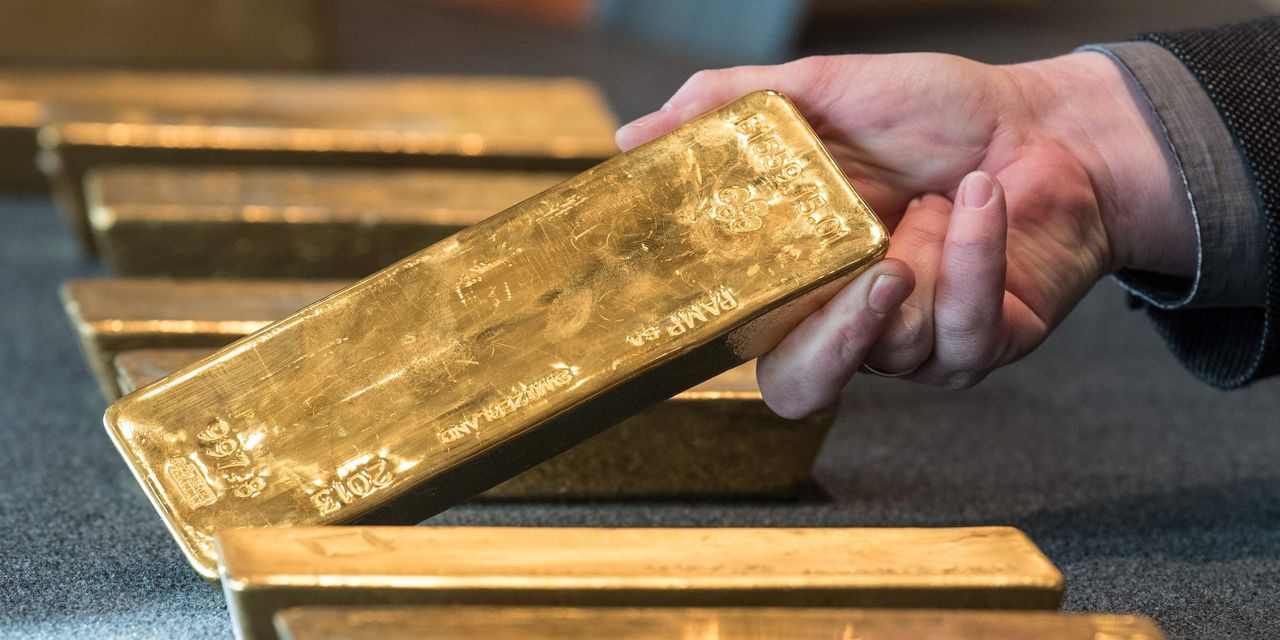Gold has more reasons to rise in the wake of the Federal Reserve’s decision in November to stand pat on interest rates, helping to make a price climb back above $2,000 an ounce a real possibility in the last few weeks of the year.
On Wednesday, the U.S. central bank left its key interest rate at a 22-year high, in the range of 5.25% to 5.5% and said it would take into account a wide array of data to decide whether it will need to raise rates again to “return inflation to 2% over time.”
Economists said comments from Fed Chairman Jerome Powell in a post-decision press conference left open the option for the central bank to end the current rate-hike cycle.
Read: Powell adds fuel to the talk that the Fed is done hiking rates
The Fed decision had been widely expected, so gold prices “have not risen as high as in some other areas of the market,” but they are “at or very near record highs in pretty much every other major currency,” other than the U.S. dollar, said Will Rhind, chief executive officer and founder of GraniteShares, which runs the GraniteShares Gold Trust
BAR.
Fed decision’s impact
The Federal Open Market Committee’s decision to keep rates steady is positive for the gold market as Treasury yields and, more important, the U.S. dollar have declined as a result, Rhind told MarketWatch.
Weakness in the dollar tends to decrease the opportunity costs for investors considering dollar-priced gold as an option versus other perceived havens. Lower yields, meanwhile, tend to raise the prospects for gold against government bonds.
On Thursday, the yield on the 10-year Treasury
BX:TMUBMUSD10Y
was at 4.695%, down from 4.790% on Wednesday. The ICE U.S. Dollar index
DXY
fell by 0.6% to 106.221.
“There are probably more reasons to be bullish on gold now than bearish,” Rhind said. “Prices could indeed hit $2,000 before year-end.”
Earlier this year, gold futures on May 4 saw its most-active contract trade as high as $2,085.40 an ounce on Comex and settle as high as $2,055.70, according to Dow Jones Market Data.
On Thursday, gold for December delivery
GC00,
GCZ23,
settled at $1,993.50 an ounce, up $6, or 0.3%.
While the Fed will “remain data dependent, there were no overt signals” for its policy decision in December, said Peter Grant, vice president and senior metals strategist at Zaner Metals.
With inflation still well above the 2% target and the economy showing remarkable resilience, Grant told MarketWatch that the “the higher-for-longer mantra remains very much in place.”
He believes “strong U.S. yields should help underpin the dollar, and provide at least somewhat of a headwind for gold.”
Rhind, however, sees a fall in the U.S. dollar as the “biggest catalyst” for gold potentially moving higher.
A fall in the dollar could come “by way of a significant negative investor reaction to the record levels of debt and deficit spending from the U.S. government,” said Rhind. “If investors lose confidence in the dollar, they will look for alternatives and gold has historically always been one of the best hedges against the dollar.”
Global central bank demand
Robust gold demand from central banks also has made a big impact on the market.
“Strong net purchases of gold for official reserves by primarily emerging market central banks have been a feature of the gold market for more than 13 years now,” said George Milling-Stanley, chief gold strategist at State Street Global Advisors. That looks to be “useful support for gold prices for the foreseeable future.”
Gold purchases by global central banks reached a record for the first nine months of this year, at 800,000 metric tons, according to the World Gold Council. Central bank purchases of gold had reached a record in 2022, with the full-year total at 1,136 metric tons.
Last year, central bank buying received “added impetus from the decision of the U.S. government to ‘weaponize’ the international payments system, as some commentators have called it,” said Milling-Stanley. “That helped to push net central bank buying to the highest levels we have ever seen.”
He expects to see continued strength in gold purchases among central banks this year.
Wartime boost
The start of war in the Middle East between Israel and Hamas has contributed to the rise in gold, with prices for the precious metal posting a gain of nearly 7% in October after posting two consecutive monthly losses.
“Gold prices will be driven more by the conflict in the Middle East rather than FOMC policy,” Chris Gaffney, president of World Markets at EverBank, told MarketWatch. “The Fed may or may not be at ‘peak rates’ but interest rates are certainly near the top, so focus for precious metals investors has now shifted to geopolitical concerns.”
On Thursday, Israeli troops advanced toward Gaza City even as U.S. and Arab mediators continued to push for a cease fire.
“Geopolitical risks remain high and the in the case of the Middle East, the risk of escalation is omnipresent,” said GraniteShares’ Rhind. At the same time, the war in Ukraine, which began early last year, “continues to rage, and there are risks of further escalation that cannot be ignored.”
Pullback potential
Indeed, gold prices have seen an impressive rally following the Hamas attack on Israel.
Recent gains have “returned considerable credence to the long-term uptrend” for gold, said Grant, adding that he considers a retest of the $2,067, $2,070.63, and $2,075.28 levels to be “likely at this point.”
The all-time intraday high for most-active gold futures stands at $2,089.20 from Aug. 7, 2020.
The $2,000 mark is an “important psychological level” for gold, and breaching through that will set the market up for a longer rally, with $2,500 “possible in the next couple of years,” said EverBank’s Gaffney.
Still, given the “steepness” of gold’s rally, Grant said gold is “vulnerable to short-term corrective setbacks, particularly if the war in Gaza stagnates.”
Incoming economic data that raises the prospects of a December rate hike, including an especially strong U.S. jobs report on Friday, “could add to corrective pressures” on gold, he said.
Read the full article here







